HR Skills, Development, and HPW Analysis: A Sainsbury's Case Study
VerifiedAdded on 2023/06/07
|14
|4422
|306
Report
AI Summary
This report provides a comprehensive analysis of developing individuals, teams, and organizations, with a focus on the role of HR professionals and the implementation of effective learning and development strategies. It begins by defining the essential knowledge, skills, and behaviors required by HR professionals, followed by an analysis of a personal skills audit and the creation of a professional development plan tailored for a specific job role within Sainsbury's. The report then contrasts organizational and individual learning, training, and development, emphasizing the need for continuous professional development to drive sustainable business performance. Furthermore, it explores how high-performance work (HPW) contributes to employee engagement and competitive advantage within Sainsbury's, and evaluates different approaches to performance management, highlighting their effectiveness in supporting a high-performance culture and commitment. The analysis incorporates relevant theories and practical examples to provide a thorough understanding of the key concepts and their application within a real-world organizational context.
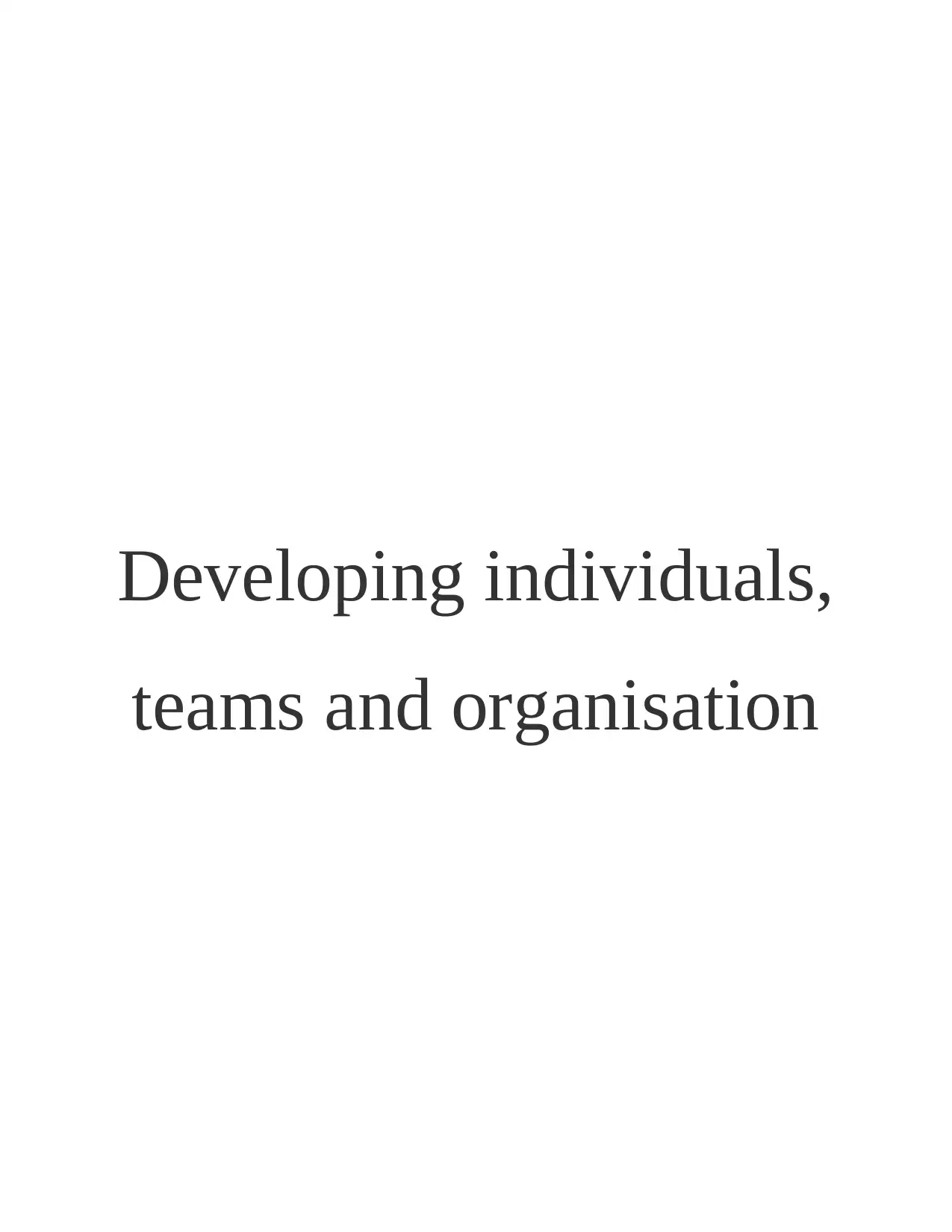
Developing individuals,
teams and organisation
teams and organisation
Paraphrase This Document
Need a fresh take? Get an instant paraphrase of this document with our AI Paraphraser
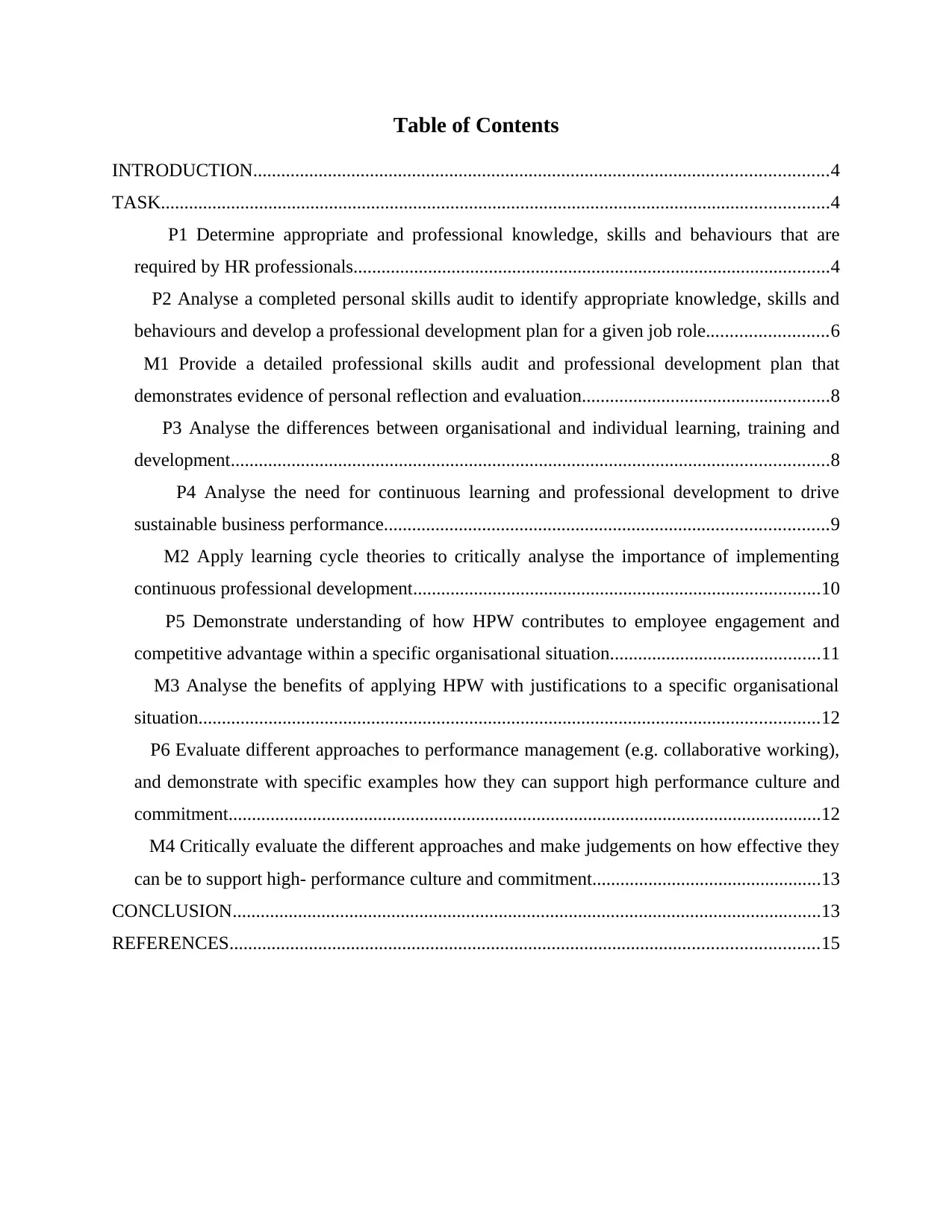
Table of Contents
INTRODUCTION...........................................................................................................................4
TASK...............................................................................................................................................4
P1 Determine appropriate and professional knowledge, skills and behaviours that are
required by HR professionals......................................................................................................4
P2 Analyse a completed personal skills audit to identify appropriate knowledge, skills and
behaviours and develop a professional development plan for a given job role..........................6
M1 Provide a detailed professional skills audit and professional development plan that
demonstrates evidence of personal reflection and evaluation.....................................................8
P3 Analyse the differences between organisational and individual learning, training and
development................................................................................................................................8
P4 Analyse the need for continuous learning and professional development to drive
sustainable business performance...............................................................................................9
M2 Apply learning cycle theories to critically analyse the importance of implementing
continuous professional development.......................................................................................10
P5 Demonstrate understanding of how HPW contributes to employee engagement and
competitive advantage within a specific organisational situation.............................................11
M3 Analyse the benefits of applying HPW with justifications to a specific organisational
situation.....................................................................................................................................12
P6 Evaluate different approaches to performance management (e.g. collaborative working),
and demonstrate with specific examples how they can support high performance culture and
commitment...............................................................................................................................12
M4 Critically evaluate the different approaches and make judgements on how effective they
can be to support high- performance culture and commitment.................................................13
CONCLUSION..............................................................................................................................13
REFERENCES..............................................................................................................................15
INTRODUCTION...........................................................................................................................4
TASK...............................................................................................................................................4
P1 Determine appropriate and professional knowledge, skills and behaviours that are
required by HR professionals......................................................................................................4
P2 Analyse a completed personal skills audit to identify appropriate knowledge, skills and
behaviours and develop a professional development plan for a given job role..........................6
M1 Provide a detailed professional skills audit and professional development plan that
demonstrates evidence of personal reflection and evaluation.....................................................8
P3 Analyse the differences between organisational and individual learning, training and
development................................................................................................................................8
P4 Analyse the need for continuous learning and professional development to drive
sustainable business performance...............................................................................................9
M2 Apply learning cycle theories to critically analyse the importance of implementing
continuous professional development.......................................................................................10
P5 Demonstrate understanding of how HPW contributes to employee engagement and
competitive advantage within a specific organisational situation.............................................11
M3 Analyse the benefits of applying HPW with justifications to a specific organisational
situation.....................................................................................................................................12
P6 Evaluate different approaches to performance management (e.g. collaborative working),
and demonstrate with specific examples how they can support high performance culture and
commitment...............................................................................................................................12
M4 Critically evaluate the different approaches and make judgements on how effective they
can be to support high- performance culture and commitment.................................................13
CONCLUSION..............................................................................................................................13
REFERENCES..............................................................................................................................15
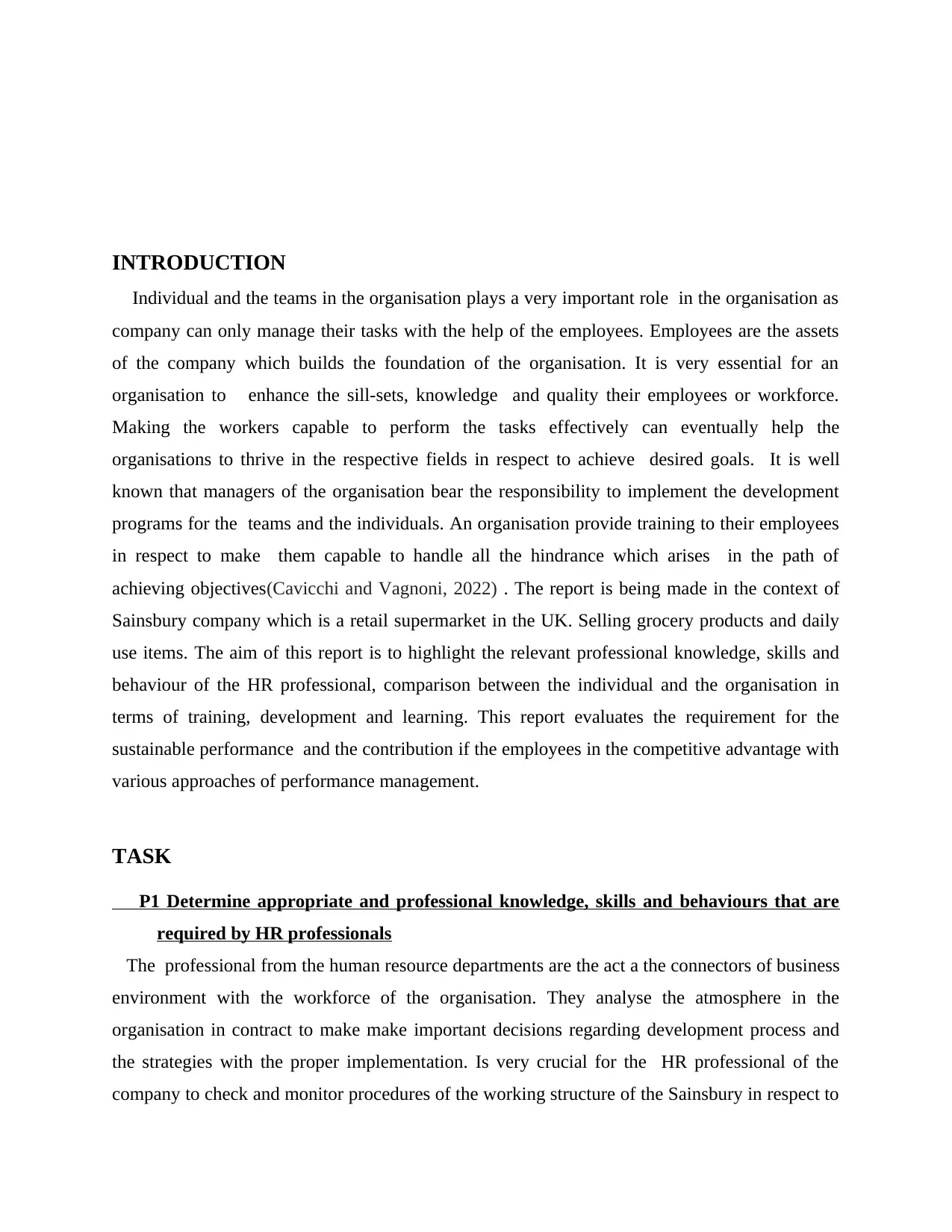
INTRODUCTION
Individual and the teams in the organisation plays a very important role in the organisation as
company can only manage their tasks with the help of the employees. Employees are the assets
of the company which builds the foundation of the organisation. It is very essential for an
organisation to enhance the sill-sets, knowledge and quality their employees or workforce.
Making the workers capable to perform the tasks effectively can eventually help the
organisations to thrive in the respective fields in respect to achieve desired goals. It is well
known that managers of the organisation bear the responsibility to implement the development
programs for the teams and the individuals. An organisation provide training to their employees
in respect to make them capable to handle all the hindrance which arises in the path of
achieving objectives(Cavicchi and Vagnoni, 2022) . The report is being made in the context of
Sainsbury company which is a retail supermarket in the UK. Selling grocery products and daily
use items. The aim of this report is to highlight the relevant professional knowledge, skills and
behaviour of the HR professional, comparison between the individual and the organisation in
terms of training, development and learning. This report evaluates the requirement for the
sustainable performance and the contribution if the employees in the competitive advantage with
various approaches of performance management.
TASK
P1 Determine appropriate and professional knowledge, skills and behaviours that are
required by HR professionals
The professional from the human resource departments are the act a the connectors of business
environment with the workforce of the organisation. They analyse the atmosphere in the
organisation in contract to make make important decisions regarding development process and
the strategies with the proper implementation. Is very crucial for the HR professional of the
company to check and monitor procedures of the working structure of the Sainsbury in respect to
Individual and the teams in the organisation plays a very important role in the organisation as
company can only manage their tasks with the help of the employees. Employees are the assets
of the company which builds the foundation of the organisation. It is very essential for an
organisation to enhance the sill-sets, knowledge and quality their employees or workforce.
Making the workers capable to perform the tasks effectively can eventually help the
organisations to thrive in the respective fields in respect to achieve desired goals. It is well
known that managers of the organisation bear the responsibility to implement the development
programs for the teams and the individuals. An organisation provide training to their employees
in respect to make them capable to handle all the hindrance which arises in the path of
achieving objectives(Cavicchi and Vagnoni, 2022) . The report is being made in the context of
Sainsbury company which is a retail supermarket in the UK. Selling grocery products and daily
use items. The aim of this report is to highlight the relevant professional knowledge, skills and
behaviour of the HR professional, comparison between the individual and the organisation in
terms of training, development and learning. This report evaluates the requirement for the
sustainable performance and the contribution if the employees in the competitive advantage with
various approaches of performance management.
TASK
P1 Determine appropriate and professional knowledge, skills and behaviours that are
required by HR professionals
The professional from the human resource departments are the act a the connectors of business
environment with the workforce of the organisation. They analyse the atmosphere in the
organisation in contract to make make important decisions regarding development process and
the strategies with the proper implementation. Is very crucial for the HR professional of the
company to check and monitor procedures of the working structure of the Sainsbury in respect to
⊘ This is a preview!⊘
Do you want full access?
Subscribe today to unlock all pages.

Trusted by 1+ million students worldwide
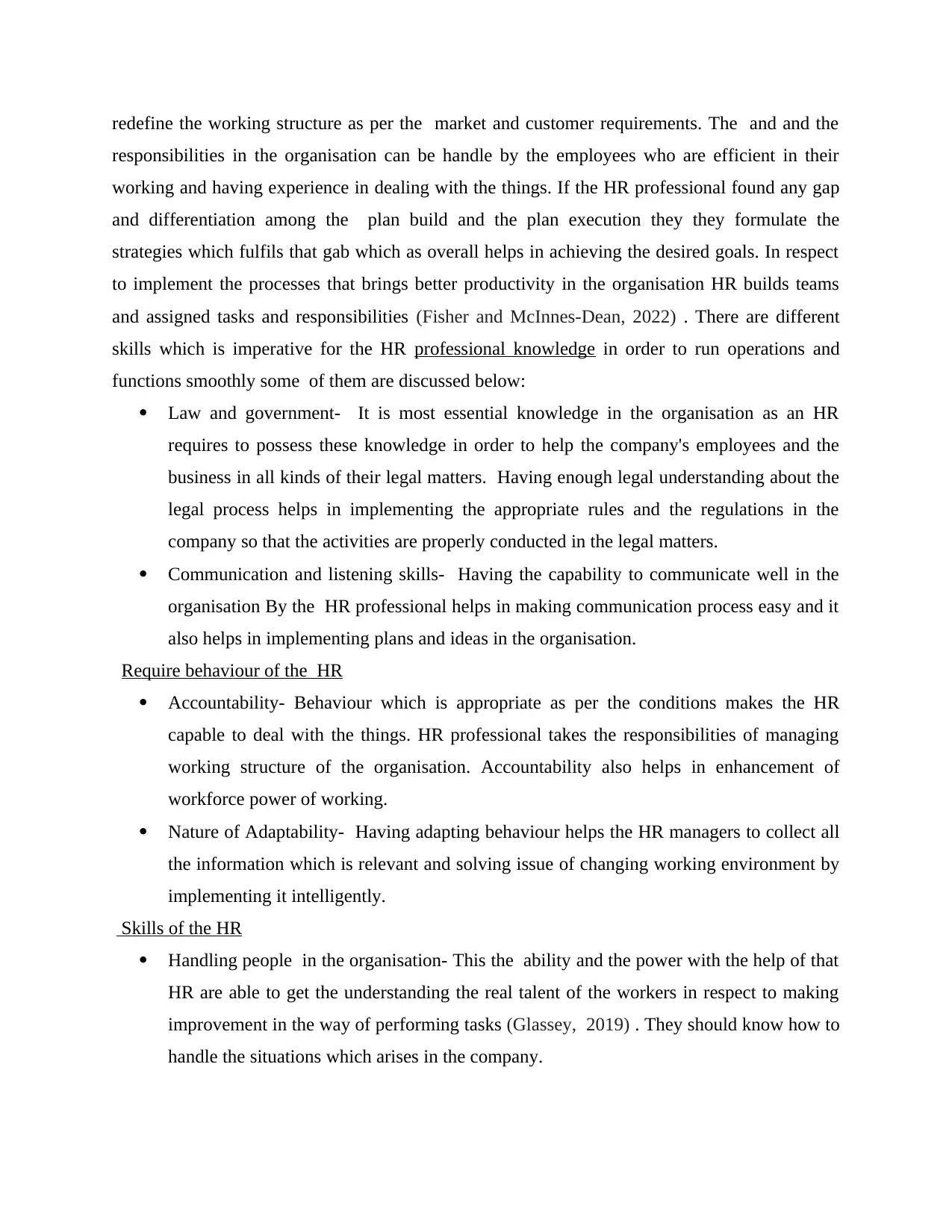
redefine the working structure as per the market and customer requirements. The and and the
responsibilities in the organisation can be handle by the employees who are efficient in their
working and having experience in dealing with the things. If the HR professional found any gap
and differentiation among the plan build and the plan execution they they formulate the
strategies which fulfils that gab which as overall helps in achieving the desired goals. In respect
to implement the processes that brings better productivity in the organisation HR builds teams
and assigned tasks and responsibilities (Fisher and McInnes‐Dean, 2022) . There are different
skills which is imperative for the HR professional knowledge in order to run operations and
functions smoothly some of them are discussed below:
Law and government- It is most essential knowledge in the organisation as an HR
requires to possess these knowledge in order to help the company's employees and the
business in all kinds of their legal matters. Having enough legal understanding about the
legal process helps in implementing the appropriate rules and the regulations in the
company so that the activities are properly conducted in the legal matters.
Communication and listening skills- Having the capability to communicate well in the
organisation By the HR professional helps in making communication process easy and it
also helps in implementing plans and ideas in the organisation.
Require behaviour of the HR
Accountability- Behaviour which is appropriate as per the conditions makes the HR
capable to deal with the things. HR professional takes the responsibilities of managing
working structure of the organisation. Accountability also helps in enhancement of
workforce power of working.
Nature of Adaptability- Having adapting behaviour helps the HR managers to collect all
the information which is relevant and solving issue of changing working environment by
implementing it intelligently.
Skills of the HR
Handling people in the organisation- This the ability and the power with the help of that
HR are able to get the understanding the real talent of the workers in respect to making
improvement in the way of performing tasks (Glassey, 2019) . They should know how to
handle the situations which arises in the company.
responsibilities in the organisation can be handle by the employees who are efficient in their
working and having experience in dealing with the things. If the HR professional found any gap
and differentiation among the plan build and the plan execution they they formulate the
strategies which fulfils that gab which as overall helps in achieving the desired goals. In respect
to implement the processes that brings better productivity in the organisation HR builds teams
and assigned tasks and responsibilities (Fisher and McInnes‐Dean, 2022) . There are different
skills which is imperative for the HR professional knowledge in order to run operations and
functions smoothly some of them are discussed below:
Law and government- It is most essential knowledge in the organisation as an HR
requires to possess these knowledge in order to help the company's employees and the
business in all kinds of their legal matters. Having enough legal understanding about the
legal process helps in implementing the appropriate rules and the regulations in the
company so that the activities are properly conducted in the legal matters.
Communication and listening skills- Having the capability to communicate well in the
organisation By the HR professional helps in making communication process easy and it
also helps in implementing plans and ideas in the organisation.
Require behaviour of the HR
Accountability- Behaviour which is appropriate as per the conditions makes the HR
capable to deal with the things. HR professional takes the responsibilities of managing
working structure of the organisation. Accountability also helps in enhancement of
workforce power of working.
Nature of Adaptability- Having adapting behaviour helps the HR managers to collect all
the information which is relevant and solving issue of changing working environment by
implementing it intelligently.
Skills of the HR
Handling people in the organisation- This the ability and the power with the help of that
HR are able to get the understanding the real talent of the workers in respect to making
improvement in the way of performing tasks (Glassey, 2019) . They should know how to
handle the situations which arises in the company.
Paraphrase This Document
Need a fresh take? Get an instant paraphrase of this document with our AI Paraphraser
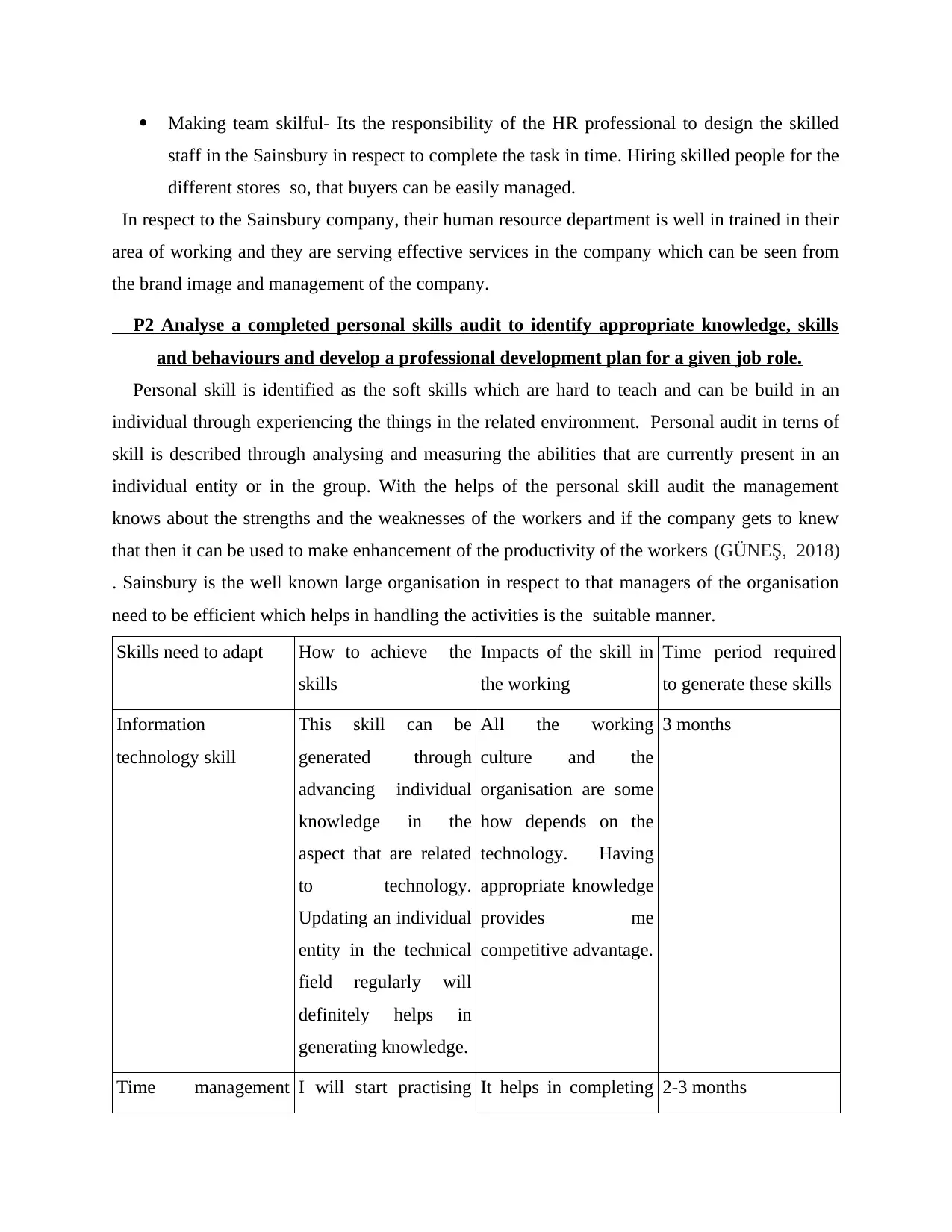
Making team skilful- Its the responsibility of the HR professional to design the skilled
staff in the Sainsbury in respect to complete the task in time. Hiring skilled people for the
different stores so, that buyers can be easily managed.
In respect to the Sainsbury company, their human resource department is well in trained in their
area of working and they are serving effective services in the company which can be seen from
the brand image and management of the company.
P2 Analyse a completed personal skills audit to identify appropriate knowledge, skills
and behaviours and develop a professional development plan for a given job role.
Personal skill is identified as the soft skills which are hard to teach and can be build in an
individual through experiencing the things in the related environment. Personal audit in terns of
skill is described through analysing and measuring the abilities that are currently present in an
individual entity or in the group. With the helps of the personal skill audit the management
knows about the strengths and the weaknesses of the workers and if the company gets to knew
that then it can be used to make enhancement of the productivity of the workers (GÜNEŞ, 2018)
. Sainsbury is the well known large organisation in respect to that managers of the organisation
need to be efficient which helps in handling the activities is the suitable manner.
Skills need to adapt How to achieve the
skills
Impacts of the skill in
the working
Time period required
to generate these skills
Information
technology skill
This skill can be
generated through
advancing individual
knowledge in the
aspect that are related
to technology.
Updating an individual
entity in the technical
field regularly will
definitely helps in
generating knowledge.
All the working
culture and the
organisation are some
how depends on the
technology. Having
appropriate knowledge
provides me
competitive advantage.
3 months
Time management I will start practising It helps in completing 2-3 months
staff in the Sainsbury in respect to complete the task in time. Hiring skilled people for the
different stores so, that buyers can be easily managed.
In respect to the Sainsbury company, their human resource department is well in trained in their
area of working and they are serving effective services in the company which can be seen from
the brand image and management of the company.
P2 Analyse a completed personal skills audit to identify appropriate knowledge, skills
and behaviours and develop a professional development plan for a given job role.
Personal skill is identified as the soft skills which are hard to teach and can be build in an
individual through experiencing the things in the related environment. Personal audit in terns of
skill is described through analysing and measuring the abilities that are currently present in an
individual entity or in the group. With the helps of the personal skill audit the management
knows about the strengths and the weaknesses of the workers and if the company gets to knew
that then it can be used to make enhancement of the productivity of the workers (GÜNEŞ, 2018)
. Sainsbury is the well known large organisation in respect to that managers of the organisation
need to be efficient which helps in handling the activities is the suitable manner.
Skills need to adapt How to achieve the
skills
Impacts of the skill in
the working
Time period required
to generate these skills
Information
technology skill
This skill can be
generated through
advancing individual
knowledge in the
aspect that are related
to technology.
Updating an individual
entity in the technical
field regularly will
definitely helps in
generating knowledge.
All the working
culture and the
organisation are some
how depends on the
technology. Having
appropriate knowledge
provides me
competitive advantage.
3 months
Time management I will start practising It helps in completing 2-3 months
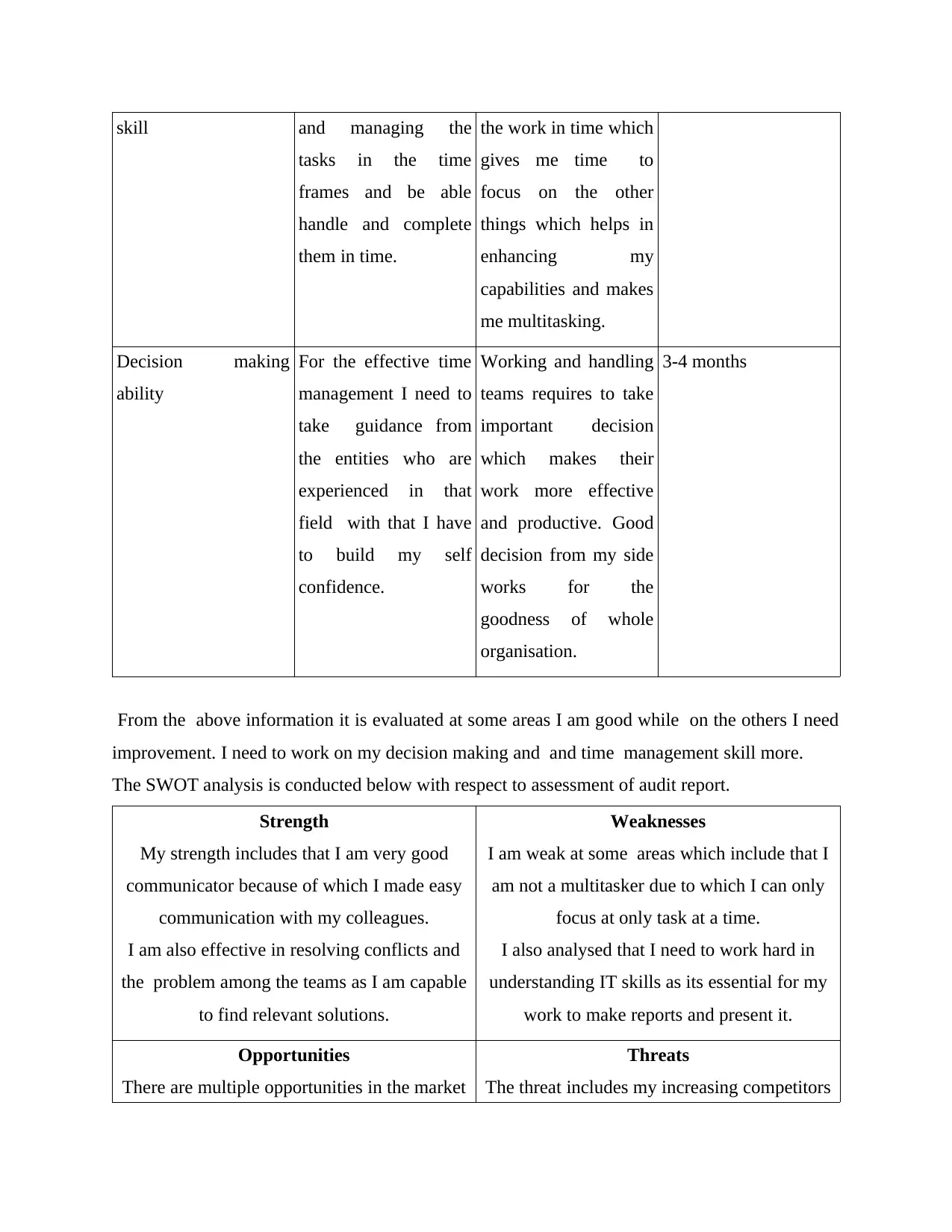
skill and managing the
tasks in the time
frames and be able
handle and complete
them in time.
the work in time which
gives me time to
focus on the other
things which helps in
enhancing my
capabilities and makes
me multitasking.
Decision making
ability
For the effective time
management I need to
take guidance from
the entities who are
experienced in that
field with that I have
to build my self
confidence.
Working and handling
teams requires to take
important decision
which makes their
work more effective
and productive. Good
decision from my side
works for the
goodness of whole
organisation.
3-4 months
From the above information it is evaluated at some areas I am good while on the others I need
improvement. I need to work on my decision making and and time management skill more.
The SWOT analysis is conducted below with respect to assessment of audit report.
Strength
My strength includes that I am very good
communicator because of which I made easy
communication with my colleagues.
I am also effective in resolving conflicts and
the problem among the teams as I am capable
to find relevant solutions.
Weaknesses
I am weak at some areas which include that I
am not a multitasker due to which I can only
focus at only task at a time.
I also analysed that I need to work hard in
understanding IT skills as its essential for my
work to make reports and present it.
Opportunities
There are multiple opportunities in the market
Threats
The threat includes my increasing competitors
tasks in the time
frames and be able
handle and complete
them in time.
the work in time which
gives me time to
focus on the other
things which helps in
enhancing my
capabilities and makes
me multitasking.
Decision making
ability
For the effective time
management I need to
take guidance from
the entities who are
experienced in that
field with that I have
to build my self
confidence.
Working and handling
teams requires to take
important decision
which makes their
work more effective
and productive. Good
decision from my side
works for the
goodness of whole
organisation.
3-4 months
From the above information it is evaluated at some areas I am good while on the others I need
improvement. I need to work on my decision making and and time management skill more.
The SWOT analysis is conducted below with respect to assessment of audit report.
Strength
My strength includes that I am very good
communicator because of which I made easy
communication with my colleagues.
I am also effective in resolving conflicts and
the problem among the teams as I am capable
to find relevant solutions.
Weaknesses
I am weak at some areas which include that I
am not a multitasker due to which I can only
focus at only task at a time.
I also analysed that I need to work hard in
understanding IT skills as its essential for my
work to make reports and present it.
Opportunities
There are multiple opportunities in the market
Threats
The threat includes my increasing competitors
⊘ This is a preview!⊘
Do you want full access?
Subscribe today to unlock all pages.

Trusted by 1+ million students worldwide
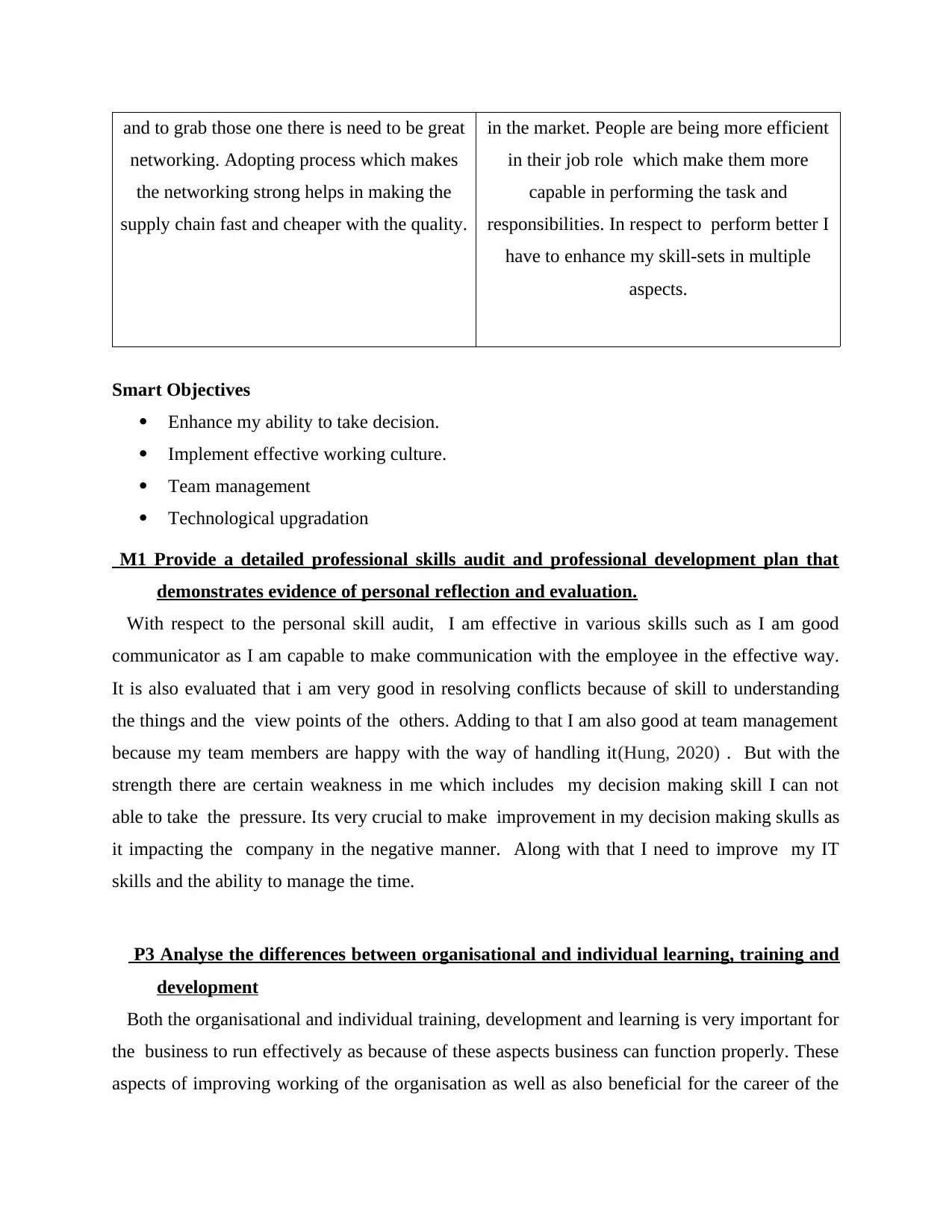
and to grab those one there is need to be great
networking. Adopting process which makes
the networking strong helps in making the
supply chain fast and cheaper with the quality.
in the market. People are being more efficient
in their job role which make them more
capable in performing the task and
responsibilities. In respect to perform better I
have to enhance my skill-sets in multiple
aspects.
Smart Objectives
Enhance my ability to take decision.
Implement effective working culture.
Team management
Technological upgradation
M1 Provide a detailed professional skills audit and professional development plan that
demonstrates evidence of personal reflection and evaluation.
With respect to the personal skill audit, I am effective in various skills such as I am good
communicator as I am capable to make communication with the employee in the effective way.
It is also evaluated that i am very good in resolving conflicts because of skill to understanding
the things and the view points of the others. Adding to that I am also good at team management
because my team members are happy with the way of handling it(Hung, 2020) . But with the
strength there are certain weakness in me which includes my decision making skill I can not
able to take the pressure. Its very crucial to make improvement in my decision making skulls as
it impacting the company in the negative manner. Along with that I need to improve my IT
skills and the ability to manage the time.
P3 Analyse the differences between organisational and individual learning, training and
development
Both the organisational and individual training, development and learning is very important for
the business to run effectively as because of these aspects business can function properly. These
aspects of improving working of the organisation as well as also beneficial for the career of the
networking. Adopting process which makes
the networking strong helps in making the
supply chain fast and cheaper with the quality.
in the market. People are being more efficient
in their job role which make them more
capable in performing the task and
responsibilities. In respect to perform better I
have to enhance my skill-sets in multiple
aspects.
Smart Objectives
Enhance my ability to take decision.
Implement effective working culture.
Team management
Technological upgradation
M1 Provide a detailed professional skills audit and professional development plan that
demonstrates evidence of personal reflection and evaluation.
With respect to the personal skill audit, I am effective in various skills such as I am good
communicator as I am capable to make communication with the employee in the effective way.
It is also evaluated that i am very good in resolving conflicts because of skill to understanding
the things and the view points of the others. Adding to that I am also good at team management
because my team members are happy with the way of handling it(Hung, 2020) . But with the
strength there are certain weakness in me which includes my decision making skill I can not
able to take the pressure. Its very crucial to make improvement in my decision making skulls as
it impacting the company in the negative manner. Along with that I need to improve my IT
skills and the ability to manage the time.
P3 Analyse the differences between organisational and individual learning, training and
development
Both the organisational and individual training, development and learning is very important for
the business to run effectively as because of these aspects business can function properly. These
aspects of improving working of the organisation as well as also beneficial for the career of the
Paraphrase This Document
Need a fresh take? Get an instant paraphrase of this document with our AI Paraphraser
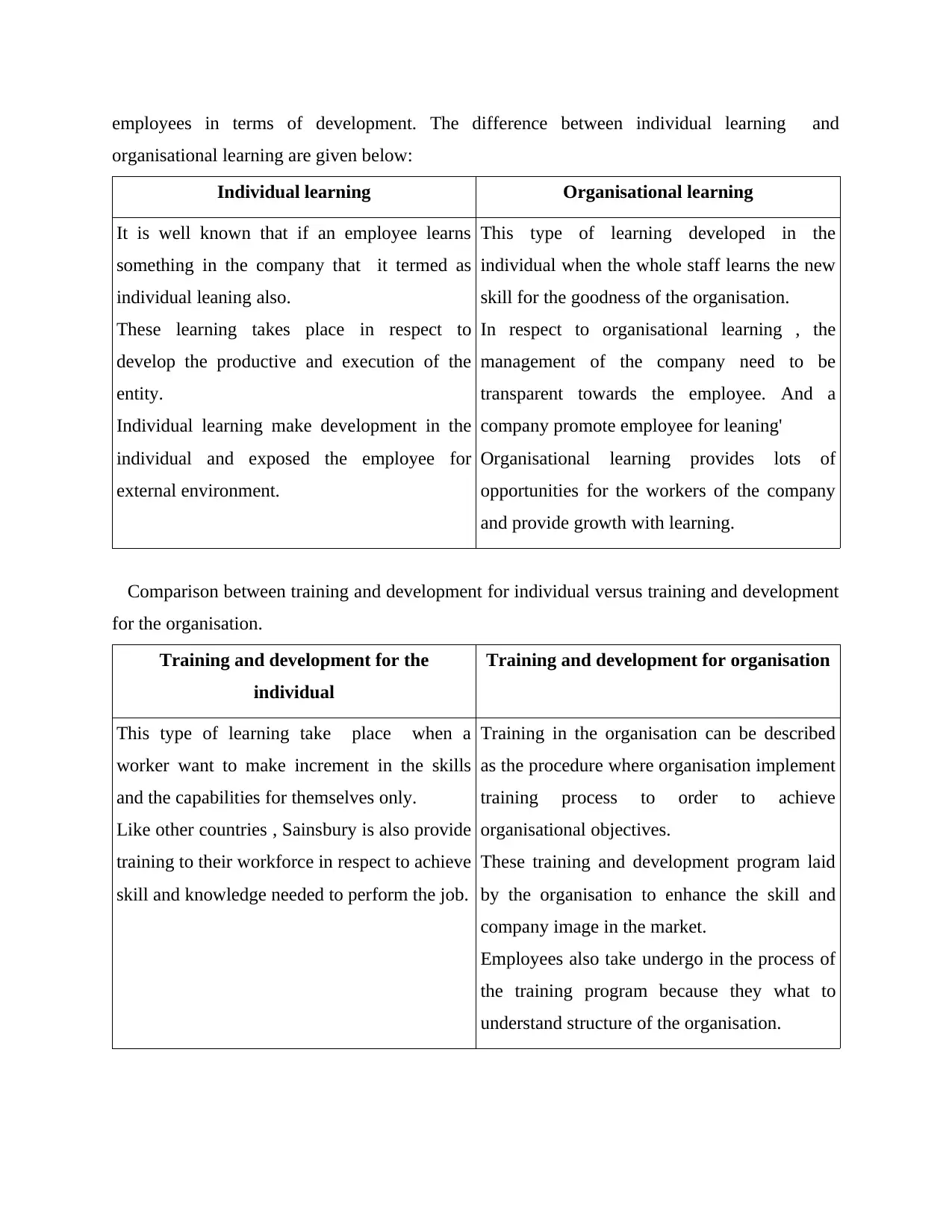
employees in terms of development. The difference between individual learning and
organisational learning are given below:
Individual learning Organisational learning
It is well known that if an employee learns
something in the company that it termed as
individual leaning also.
These learning takes place in respect to
develop the productive and execution of the
entity.
Individual learning make development in the
individual and exposed the employee for
external environment.
This type of learning developed in the
individual when the whole staff learns the new
skill for the goodness of the organisation.
In respect to organisational learning , the
management of the company need to be
transparent towards the employee. And a
company promote employee for leaning'
Organisational learning provides lots of
opportunities for the workers of the company
and provide growth with learning.
Comparison between training and development for individual versus training and development
for the organisation.
Training and development for the
individual
Training and development for organisation
This type of learning take place when a
worker want to make increment in the skills
and the capabilities for themselves only.
Like other countries , Sainsbury is also provide
training to their workforce in respect to achieve
skill and knowledge needed to perform the job.
Training in the organisation can be described
as the procedure where organisation implement
training process to order to achieve
organisational objectives.
These training and development program laid
by the organisation to enhance the skill and
company image in the market.
Employees also take undergo in the process of
the training program because they what to
understand structure of the organisation.
organisational learning are given below:
Individual learning Organisational learning
It is well known that if an employee learns
something in the company that it termed as
individual leaning also.
These learning takes place in respect to
develop the productive and execution of the
entity.
Individual learning make development in the
individual and exposed the employee for
external environment.
This type of learning developed in the
individual when the whole staff learns the new
skill for the goodness of the organisation.
In respect to organisational learning , the
management of the company need to be
transparent towards the employee. And a
company promote employee for leaning'
Organisational learning provides lots of
opportunities for the workers of the company
and provide growth with learning.
Comparison between training and development for individual versus training and development
for the organisation.
Training and development for the
individual
Training and development for organisation
This type of learning take place when a
worker want to make increment in the skills
and the capabilities for themselves only.
Like other countries , Sainsbury is also provide
training to their workforce in respect to achieve
skill and knowledge needed to perform the job.
Training in the organisation can be described
as the procedure where organisation implement
training process to order to achieve
organisational objectives.
These training and development program laid
by the organisation to enhance the skill and
company image in the market.
Employees also take undergo in the process of
the training program because they what to
understand structure of the organisation.
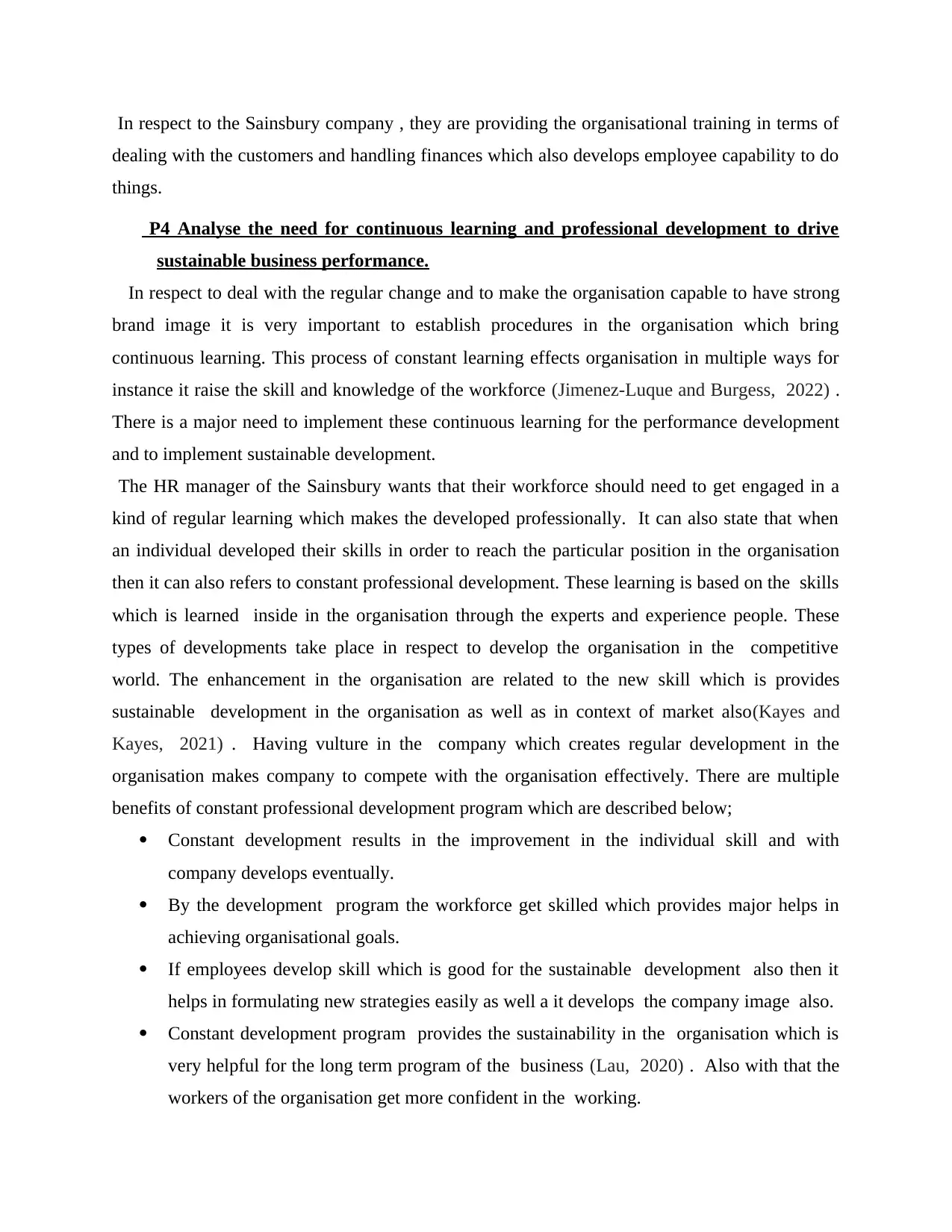
In respect to the Sainsbury company , they are providing the organisational training in terms of
dealing with the customers and handling finances which also develops employee capability to do
things.
P4 Analyse the need for continuous learning and professional development to drive
sustainable business performance.
In respect to deal with the regular change and to make the organisation capable to have strong
brand image it is very important to establish procedures in the organisation which bring
continuous learning. This process of constant learning effects organisation in multiple ways for
instance it raise the skill and knowledge of the workforce (Jimenez-Luque and Burgess, 2022) .
There is a major need to implement these continuous learning for the performance development
and to implement sustainable development.
The HR manager of the Sainsbury wants that their workforce should need to get engaged in a
kind of regular learning which makes the developed professionally. It can also state that when
an individual developed their skills in order to reach the particular position in the organisation
then it can also refers to constant professional development. These learning is based on the skills
which is learned inside in the organisation through the experts and experience people. These
types of developments take place in respect to develop the organisation in the competitive
world. The enhancement in the organisation are related to the new skill which is provides
sustainable development in the organisation as well as in context of market also(Kayes and
Kayes, 2021) . Having vulture in the company which creates regular development in the
organisation makes company to compete with the organisation effectively. There are multiple
benefits of constant professional development program which are described below;
Constant development results in the improvement in the individual skill and with
company develops eventually.
By the development program the workforce get skilled which provides major helps in
achieving organisational goals.
If employees develop skill which is good for the sustainable development also then it
helps in formulating new strategies easily as well a it develops the company image also.
Constant development program provides the sustainability in the organisation which is
very helpful for the long term program of the business (Lau, 2020) . Also with that the
workers of the organisation get more confident in the working.
dealing with the customers and handling finances which also develops employee capability to do
things.
P4 Analyse the need for continuous learning and professional development to drive
sustainable business performance.
In respect to deal with the regular change and to make the organisation capable to have strong
brand image it is very important to establish procedures in the organisation which bring
continuous learning. This process of constant learning effects organisation in multiple ways for
instance it raise the skill and knowledge of the workforce (Jimenez-Luque and Burgess, 2022) .
There is a major need to implement these continuous learning for the performance development
and to implement sustainable development.
The HR manager of the Sainsbury wants that their workforce should need to get engaged in a
kind of regular learning which makes the developed professionally. It can also state that when
an individual developed their skills in order to reach the particular position in the organisation
then it can also refers to constant professional development. These learning is based on the skills
which is learned inside in the organisation through the experts and experience people. These
types of developments take place in respect to develop the organisation in the competitive
world. The enhancement in the organisation are related to the new skill which is provides
sustainable development in the organisation as well as in context of market also(Kayes and
Kayes, 2021) . Having vulture in the company which creates regular development in the
organisation makes company to compete with the organisation effectively. There are multiple
benefits of constant professional development program which are described below;
Constant development results in the improvement in the individual skill and with
company develops eventually.
By the development program the workforce get skilled which provides major helps in
achieving organisational goals.
If employees develop skill which is good for the sustainable development also then it
helps in formulating new strategies easily as well a it develops the company image also.
Constant development program provides the sustainability in the organisation which is
very helpful for the long term program of the business (Lau, 2020) . Also with that the
workers of the organisation get more confident in the working.
⊘ This is a preview!⊘
Do you want full access?
Subscribe today to unlock all pages.

Trusted by 1+ million students worldwide
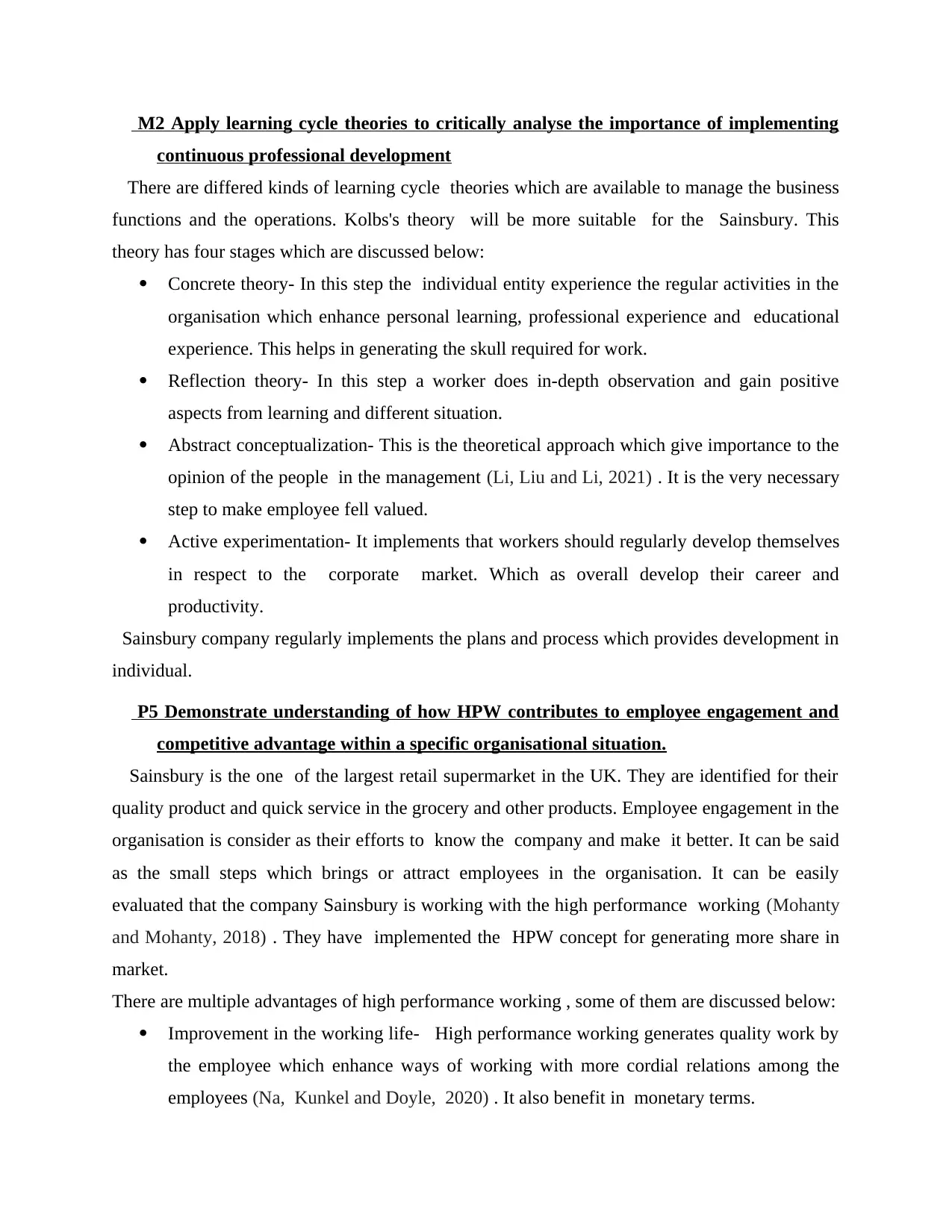
M2 Apply learning cycle theories to critically analyse the importance of implementing
continuous professional development
There are differed kinds of learning cycle theories which are available to manage the business
functions and the operations. Kolbs's theory will be more suitable for the Sainsbury. This
theory has four stages which are discussed below:
Concrete theory- In this step the individual entity experience the regular activities in the
organisation which enhance personal learning, professional experience and educational
experience. This helps in generating the skull required for work.
Reflection theory- In this step a worker does in-depth observation and gain positive
aspects from learning and different situation.
Abstract conceptualization- This is the theoretical approach which give importance to the
opinion of the people in the management (Li, Liu and Li, 2021) . It is the very necessary
step to make employee fell valued.
Active experimentation- It implements that workers should regularly develop themselves
in respect to the corporate market. Which as overall develop their career and
productivity.
Sainsbury company regularly implements the plans and process which provides development in
individual.
P5 Demonstrate understanding of how HPW contributes to employee engagement and
competitive advantage within a specific organisational situation.
Sainsbury is the one of the largest retail supermarket in the UK. They are identified for their
quality product and quick service in the grocery and other products. Employee engagement in the
organisation is consider as their efforts to know the company and make it better. It can be said
as the small steps which brings or attract employees in the organisation. It can be easily
evaluated that the company Sainsbury is working with the high performance working (Mohanty
and Mohanty, 2018) . They have implemented the HPW concept for generating more share in
market.
There are multiple advantages of high performance working , some of them are discussed below:
Improvement in the working life- High performance working generates quality work by
the employee which enhance ways of working with more cordial relations among the
employees (Na, Kunkel and Doyle, 2020) . It also benefit in monetary terms.
continuous professional development
There are differed kinds of learning cycle theories which are available to manage the business
functions and the operations. Kolbs's theory will be more suitable for the Sainsbury. This
theory has four stages which are discussed below:
Concrete theory- In this step the individual entity experience the regular activities in the
organisation which enhance personal learning, professional experience and educational
experience. This helps in generating the skull required for work.
Reflection theory- In this step a worker does in-depth observation and gain positive
aspects from learning and different situation.
Abstract conceptualization- This is the theoretical approach which give importance to the
opinion of the people in the management (Li, Liu and Li, 2021) . It is the very necessary
step to make employee fell valued.
Active experimentation- It implements that workers should regularly develop themselves
in respect to the corporate market. Which as overall develop their career and
productivity.
Sainsbury company regularly implements the plans and process which provides development in
individual.
P5 Demonstrate understanding of how HPW contributes to employee engagement and
competitive advantage within a specific organisational situation.
Sainsbury is the one of the largest retail supermarket in the UK. They are identified for their
quality product and quick service in the grocery and other products. Employee engagement in the
organisation is consider as their efforts to know the company and make it better. It can be said
as the small steps which brings or attract employees in the organisation. It can be easily
evaluated that the company Sainsbury is working with the high performance working (Mohanty
and Mohanty, 2018) . They have implemented the HPW concept for generating more share in
market.
There are multiple advantages of high performance working , some of them are discussed below:
Improvement in the working life- High performance working generates quality work by
the employee which enhance ways of working with more cordial relations among the
employees (Na, Kunkel and Doyle, 2020) . It also benefit in monetary terms.
Paraphrase This Document
Need a fresh take? Get an instant paraphrase of this document with our AI Paraphraser
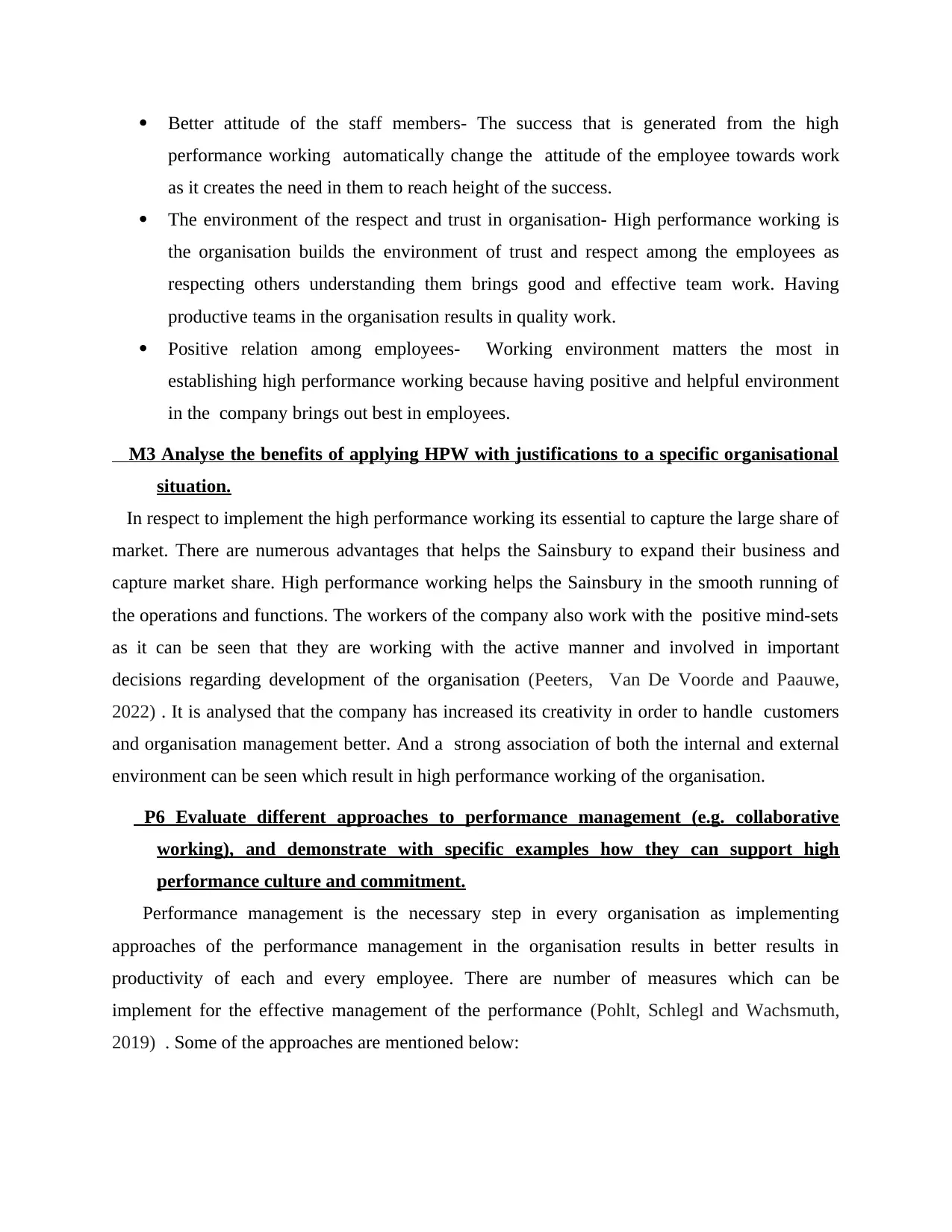
Better attitude of the staff members- The success that is generated from the high
performance working automatically change the attitude of the employee towards work
as it creates the need in them to reach height of the success.
The environment of the respect and trust in organisation- High performance working is
the organisation builds the environment of trust and respect among the employees as
respecting others understanding them brings good and effective team work. Having
productive teams in the organisation results in quality work.
Positive relation among employees- Working environment matters the most in
establishing high performance working because having positive and helpful environment
in the company brings out best in employees.
M3 Analyse the benefits of applying HPW with justifications to a specific organisational
situation.
In respect to implement the high performance working its essential to capture the large share of
market. There are numerous advantages that helps the Sainsbury to expand their business and
capture market share. High performance working helps the Sainsbury in the smooth running of
the operations and functions. The workers of the company also work with the positive mind-sets
as it can be seen that they are working with the active manner and involved in important
decisions regarding development of the organisation (Peeters, Van De Voorde and Paauwe,
2022) . It is analysed that the company has increased its creativity in order to handle customers
and organisation management better. And a strong association of both the internal and external
environment can be seen which result in high performance working of the organisation.
P6 Evaluate different approaches to performance management (e.g. collaborative
working), and demonstrate with specific examples how they can support high
performance culture and commitment.
Performance management is the necessary step in every organisation as implementing
approaches of the performance management in the organisation results in better results in
productivity of each and every employee. There are number of measures which can be
implement for the effective management of the performance (Pohlt, Schlegl and Wachsmuth,
2019) . Some of the approaches are mentioned below:
performance working automatically change the attitude of the employee towards work
as it creates the need in them to reach height of the success.
The environment of the respect and trust in organisation- High performance working is
the organisation builds the environment of trust and respect among the employees as
respecting others understanding them brings good and effective team work. Having
productive teams in the organisation results in quality work.
Positive relation among employees- Working environment matters the most in
establishing high performance working because having positive and helpful environment
in the company brings out best in employees.
M3 Analyse the benefits of applying HPW with justifications to a specific organisational
situation.
In respect to implement the high performance working its essential to capture the large share of
market. There are numerous advantages that helps the Sainsbury to expand their business and
capture market share. High performance working helps the Sainsbury in the smooth running of
the operations and functions. The workers of the company also work with the positive mind-sets
as it can be seen that they are working with the active manner and involved in important
decisions regarding development of the organisation (Peeters, Van De Voorde and Paauwe,
2022) . It is analysed that the company has increased its creativity in order to handle customers
and organisation management better. And a strong association of both the internal and external
environment can be seen which result in high performance working of the organisation.
P6 Evaluate different approaches to performance management (e.g. collaborative
working), and demonstrate with specific examples how they can support high
performance culture and commitment.
Performance management is the necessary step in every organisation as implementing
approaches of the performance management in the organisation results in better results in
productivity of each and every employee. There are number of measures which can be
implement for the effective management of the performance (Pohlt, Schlegl and Wachsmuth,
2019) . Some of the approaches are mentioned below:
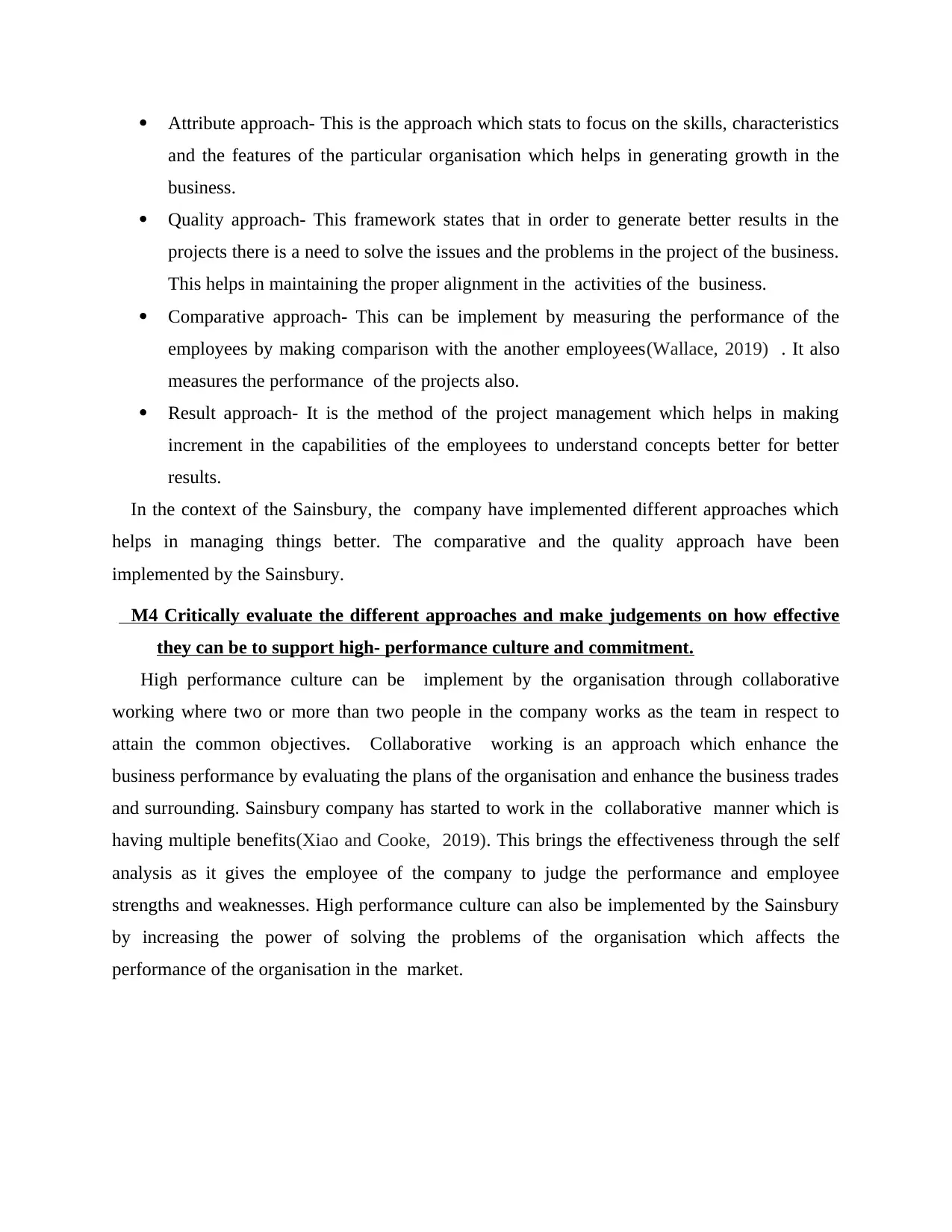
Attribute approach- This is the approach which stats to focus on the skills, characteristics
and the features of the particular organisation which helps in generating growth in the
business.
Quality approach- This framework states that in order to generate better results in the
projects there is a need to solve the issues and the problems in the project of the business.
This helps in maintaining the proper alignment in the activities of the business.
Comparative approach- This can be implement by measuring the performance of the
employees by making comparison with the another employees(Wallace, 2019) . It also
measures the performance of the projects also.
Result approach- It is the method of the project management which helps in making
increment in the capabilities of the employees to understand concepts better for better
results.
In the context of the Sainsbury, the company have implemented different approaches which
helps in managing things better. The comparative and the quality approach have been
implemented by the Sainsbury.
M4 Critically evaluate the different approaches and make judgements on how effective
they can be to support high- performance culture and commitment.
High performance culture can be implement by the organisation through collaborative
working where two or more than two people in the company works as the team in respect to
attain the common objectives. Collaborative working is an approach which enhance the
business performance by evaluating the plans of the organisation and enhance the business trades
and surrounding. Sainsbury company has started to work in the collaborative manner which is
having multiple benefits(Xiao and Cooke, 2019). This brings the effectiveness through the self
analysis as it gives the employee of the company to judge the performance and employee
strengths and weaknesses. High performance culture can also be implemented by the Sainsbury
by increasing the power of solving the problems of the organisation which affects the
performance of the organisation in the market.
and the features of the particular organisation which helps in generating growth in the
business.
Quality approach- This framework states that in order to generate better results in the
projects there is a need to solve the issues and the problems in the project of the business.
This helps in maintaining the proper alignment in the activities of the business.
Comparative approach- This can be implement by measuring the performance of the
employees by making comparison with the another employees(Wallace, 2019) . It also
measures the performance of the projects also.
Result approach- It is the method of the project management which helps in making
increment in the capabilities of the employees to understand concepts better for better
results.
In the context of the Sainsbury, the company have implemented different approaches which
helps in managing things better. The comparative and the quality approach have been
implemented by the Sainsbury.
M4 Critically evaluate the different approaches and make judgements on how effective
they can be to support high- performance culture and commitment.
High performance culture can be implement by the organisation through collaborative
working where two or more than two people in the company works as the team in respect to
attain the common objectives. Collaborative working is an approach which enhance the
business performance by evaluating the plans of the organisation and enhance the business trades
and surrounding. Sainsbury company has started to work in the collaborative manner which is
having multiple benefits(Xiao and Cooke, 2019). This brings the effectiveness through the self
analysis as it gives the employee of the company to judge the performance and employee
strengths and weaknesses. High performance culture can also be implemented by the Sainsbury
by increasing the power of solving the problems of the organisation which affects the
performance of the organisation in the market.
⊘ This is a preview!⊘
Do you want full access?
Subscribe today to unlock all pages.

Trusted by 1+ million students worldwide
1 out of 14
Related Documents
Your All-in-One AI-Powered Toolkit for Academic Success.
+13062052269
info@desklib.com
Available 24*7 on WhatsApp / Email
![[object Object]](/_next/static/media/star-bottom.7253800d.svg)
Unlock your academic potential
Copyright © 2020–2025 A2Z Services. All Rights Reserved. Developed and managed by ZUCOL.

